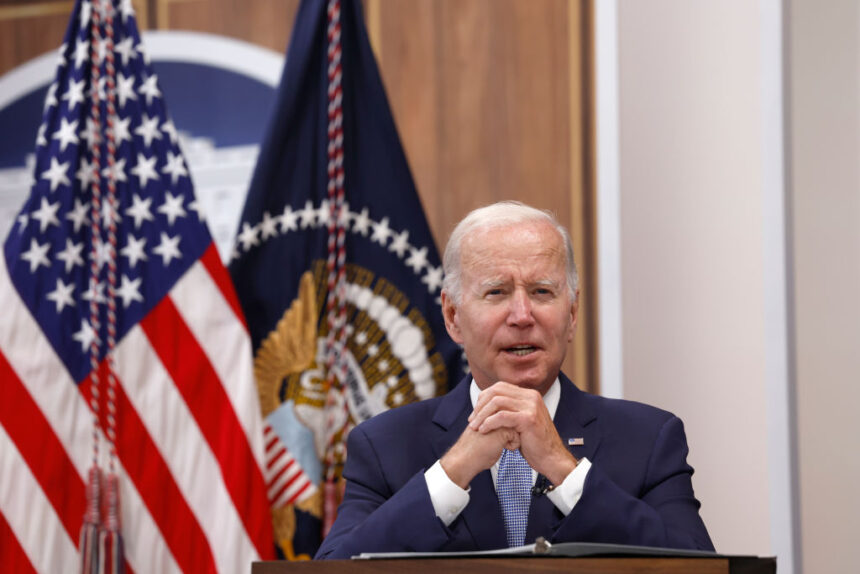The nation’s opioid epidemic, which was initially assumed to have peaked in 2017, was briefly eclipsed by all the attention around the COVID-19 pandemic. But the country slowly emerges from the COVID-19 fog, the opioid crisis continues to rage unabated.
The U.S. saw more than 107,000 drug overdose deaths in 2021, a 15% rise over 2020, according to the Centers for Disease Control and Prevention. As people continue to die, the Biden administration has embraced a new policy approach: Harm-reduction. The approach focuses on tending to the well-being of individuals with substance abuse disorder, rather than criminalizing their behavior.
Historically, harm-reduction has mostly thrived on local and community levels, in the form of syringe exchange programs and, more recently, supervised consumption sites.
The White House recently released its 2022 drug control strategy document, which officially incorporates some harm-reduction principles. It represents a marked change, according to Dr. David Fiellin, professor of medicine and director of the program in addiction medicine at Yale School of Medicine.
“The current administration has started the process that will lead to the reversal of many of the challenges that the harm-reduction community has experienced for the last 40 or 50 years,” he said.
Fiellin recalled being told to avoid using the term harm-reduction in conversations with the federal government – and in particular with the Office of National Drug Control Policy – during President George W. Bush’s tenure. Administrative restrictions and budgetary exclusions neutered any and all harm-reduction measures, which were deemphasized as the country fought “the war on drugs.”
The opioid epidemic rages unabated, however, exacerbated by COVID-19. Black and indigenous communities have been hit especially hard.
“What we’ve seen over the last 10 to 15 years is that the number of overdoses and complications related to opioid use, fentanyl use and methamphetamine use are outstripping the treatment system and its capacity to provide services,” Fiellin explained. As a result, there’s a “growing recognition” of the benefits of harm-reduction strategies, which have been embraced by a handful of European countries.
The White House’s 2022 drug control policy highlights several harm-reduction strategies, including expanding the availability of naloxone, drug test strips and syringe service programs. Funding for such programs, however, remains limited. In June 2021, Congress allocated $30 million for evidence-based harm-reduction programs.
“That is a drop in the bucket for many of the community-based organizations that are on the front line in providing harm-reduction services,” Fiellin said. “They need probably 10 to 100 times that amount, and the capacity of these programs needs to expand rapidly.”
Since then, the federal government has not increased funding. “The administration has taken important first steps, but they need to be supplemented by eliminating regulatory and legislative barriers and providing sufficient funds for the organizations that are doing real harm-reduction work,” Fiellin stressed.
The National Institute on Drug Abuse, part of the National Institutes of Health, is currently funding harm-reduction research. Results and learnings, however, probably will not be available for five to 10 years.
On the local level, cities and community organizations adopted harm-reduction models years ago. In New York City, nonprofit group OnPoint NYC began operating the first supervised injection sites in the U.S. this year.
The benefits of harm reduction have become clearer with practice and research. Access to medications for opioid use disorder, for example, has been shown to reduce mortality, drug use and HIV transmission.
Improving access to these treatment strategies should go hand-in-hand with a larger attitudinal shift around substance abuse as a medical condition rather than a crime, Fiellin said.
“It allows for a treatment system that is not unlike the treatment system that we have for, let’s say, depression or diabetes,” he explained. “As a primary care physician, I have never cured diabetes, but I work closely with my patients to reduce the harm that it can have on their bodies.”
While funding and more tangible federal harm-reduction programs remain elusive, Fiellin believes the policy shift is significant.
“In addiction, we say the first step is realizing that you have a problem,” Fiellin noted. “I think the Biden administration has started that process and recognized that they have a problem – that the devastation is outstripping the current strategies that are being deployed.”







